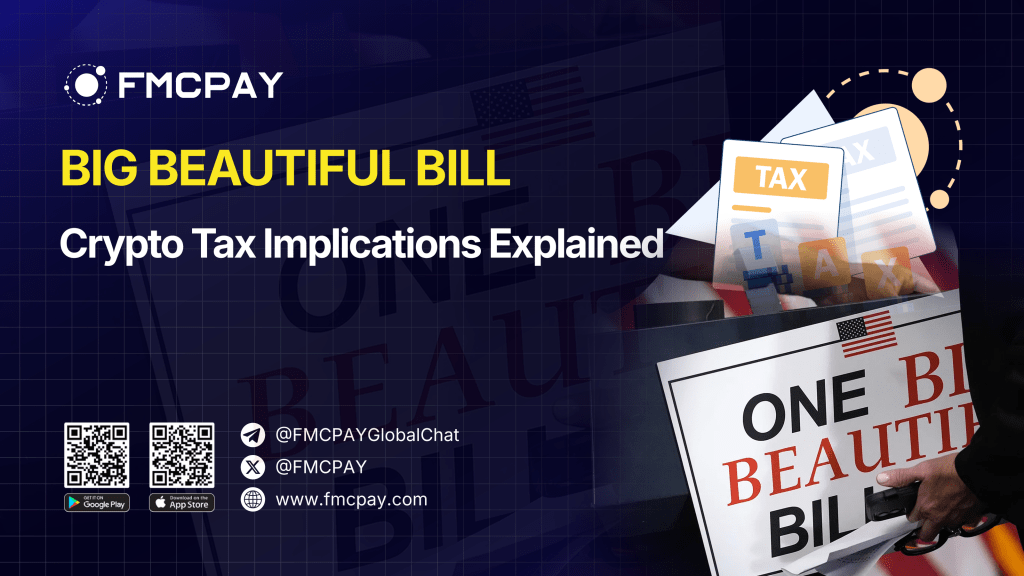In a historic milestone for both fiscal policy and blockchain innovation, the United States has passed the Big Beautiful Bill crypto tax reform the most sweeping and comprehensive digital asset tax framework the country has ever introduced. While the broader bill covers income tax cuts, deficit spending, and program restructuring, it’s the Big Beautiful Bill crypto tax provisions that are reshaping the digital asset landscape.
For the first time, the U.S. government is clearly defining how crypto staking, mining, and trading are taxed bringing long-awaited clarity, tighter enforcement, and new challenges to investors, builders, and institutions alike.
1. What Is the Big Beautiful Bill Act?
The Big Beautiful Bill Act is a landmark piece of legislation passed by the U.S. Congress in 2025, aimed at overhauling the country’s tax code, reducing federal bureaucracy, and stimulating economic growth. Backed by the Trump administration in his second term, the bill is notable for combining deep tax cuts with sweeping regulatory reforms including the first major legal recognition of digital assets.
While the bill covers a wide range of fiscal policies, from income tax relief to government spending shifts, one of its most impactful features is the Big Beautiful Bill crypto tax reform. These provisions formally integrate cryptocurrency into U.S. tax law, addressing long-standing gray areas around mining, staking, trading, and everyday usage.
Key Highlights of the Big Beautiful Bill:
-
Cuts personal income taxes and eliminates taxes on overtime and tips
-
Reduces regulatory red tape across industries
-
Rewrites how crypto is taxed, providing clarity for investors and businesses
-
Adds trillions in deficit spending, prompting debate over long-term economic impact
The bill passed by a razor-thin margin (51–50), signaling both its political importance and its controversial nature. Still, its passage marks a turning point in U.S. economic policy and in how the government treats digital innovation.
Read more about Big Beautiful Bill at: One Big Beautiful Bill Act: Crypto’s New Tax Era
2. What the Big Beautiful Bill Means for Crypto Taxation
The crypto-specific provisions in the Big Beautiful Bill crypto tax package bring long-overdue structure to how digital assets are classified, taxed, and reported in the United States. From staking rewards to trading losses, here’s a breakdown of the key changes:

2.1. Mining and Staking Rewards: Taxed at the Time of Sale
Under the Big Beautiful Bill crypto tax reforms, one of the most welcomed changes is the new treatment of mining and staking rewards. Previously, participants were taxed the moment they received these rewards even if they hadn’t sold them or had no liquidity to cover the tax burden.
Now, with the updated Big Beautiful Bill crypto tax provisions, taxation occurs only when those assets are sold.
Why it matters:
-
This policy aligns tax obligations with actual liquidity events a long-standing demand from the crypto community.
-
It helps prevent scenarios where validators owe taxes on assets that may have sharply dropped in value after issuance.
-
It provides meaningful cash flow relief for stakers and miners, especially in volatile market conditions.
Net Positive: The Big Beautiful Bill crypto tax update modernizes how blockchain infrastructure participants are taxed and brings these activities closer to traditional investment treatment encouraging more long-term participation in Proof-of-Stake networks.
2.2. Wash Sale Rule Extended to Crypto Assets
Another significant update under the Big Beautiful Bill crypto tax framework is the application of the wash sale rule to digital assets. In the past, crypto traders could harvest tax losses by selling tokens at a loss and quickly rebuying them a loophole long closed in traditional finance, but open to crypto until now.
Thanks to the Big Beautiful Bill crypto tax reform, this practice is officially curtailed.
Now:
-
Selling and repurchasing the same or a “substantially identical” asset within 30 days disqualifies the loss from being claimed.
-
This change has a direct impact on short-term trading strategies, high-frequency bots, and year-end portfolio optimization.
Implication: With the Big Beautiful Bill crypto tax rules in effect, traders will need to rethink their tax-loss strategies and prepare for more complex planning during tax season especially those running automated portfolios or active funds.
2.3. Everyday Crypto Payments Still Taxable
Despite major advocacy efforts across the crypto industry, the Big Beautiful Bill crypto tax legislation did not include a de minimis exemption — a proposal that would have excluded small crypto transactions (e.g., under $200) from capital gains taxation.
That means:
-
Every crypto payment, no matter how minor, remains a taxable event under the Big Beautiful Bill crypto tax rules.
-
Users paying for coffee, tipping creators, or donating to causes in crypto must track cost basis and calculate gains or losses.
-
This burdens casual users with the same reporting requirements as active traders.
Result: The Big Beautiful Bill crypto tax policy still treats crypto as property not currency creating friction for retail adoption, everyday transactions, and consumer-facing Web3 growth.
3. Big Beautiful Bill Crypto Tax Policy: Key Implications
The passage of the Big Beautiful Bill crypto tax provisions sparked an immediate surge in market activity, signaling a strong appetite for regulatory clarity even as questions about long-term impact continue to swirl.

3.1. Crypto Markets Rally on Regulatory Clarity
Following the bill’s approval, major cryptocurrencies posted solid gains:
-
Bitcoin (BTC) broke above $109,000, climbing more than 3% in the hours after the announcement.
-
Ethereum (ETH), Solana (SOL), and other Layer 1 assets jumped 4–6%, reflecting a wave of renewed confidence.
-
Even crypto stocks and mining firms, including Coinbase (COIN) and Marathon Digital (MARA), saw noticeable upticks as investors anticipated a friendlier compliance landscape.
This immediate market rally highlights how deeply the industry has craved clear legal guidance. For the first time, the Big Beautiful Bill crypto tax framework introduces a formal structure for how staking, mining, and trading are treated under U.S. law removing years of ambiguity.
3.2. Why the Market Responded So Strongly
Analysts point to two major forces behind the bullish reaction:
Regulatory Legitimacy for Crypto
The Big Beautiful Bill crypto tax update sends a powerful message: digital assets are no longer a legal gray zone in the U.S. economy. With clearer rules for staking, mining, and capital gains, investors especially institutions can now operate with more confidence and predictability.
-
This is particularly significant for funds that previously hesitated due to unclear tax exposure.
-
It’s also a major green light for U.S.-based fintech platforms expanding into Web3.
Deficit Spending Sparks Inflation Hedge Buying
The bill’s broader fiscal policy centered on tax cuts and deficit-financed stimulus raises expectations for inflation and dollar weakening. Historically, this macro environment has driven capital into hard assets, including Bitcoin.
-
The market’s response suggests that BTC and ETH are still viewed as inflation hedges, particularly in times of monetary expansion.
-
The Big Beautiful Bill crypto tax clarity only reinforces their investment appeal.
3.3. Long-Term Implications Still Unfolding
While the market’s immediate reaction has been positive, there are still long-term questions surrounding how the Big Beautiful Bill crypto tax rules will be enforced and expanded upon:
-
IRS Guidance Pending: Critical details about decentralized finance (DeFi), cross-chain swaps, and NFT taxation remain unresolved. Investors are watching closely for interpretive rules in the coming months.
-
Enforcement Risk: More clarity also means stronger enforcement. With tax liabilities tied to staking, wash sale rules, and transaction tracking, non-compliant users could face serious penalties.
-
Lack of de minimis exemption: The bill’s failure to exempt small crypto payments from taxation may dampen adoption for real-world use, keeping crypto primarily in the domain of investment rather than day-to-day finance.
3.4. Winners and Watchpoints
Who benefits most from the Big Beautiful Bill crypto tax changes?
-
Long-term holders, validators, and miners, who now enjoy fairer and more realistic tax timing.
-
Institutional investors, who gain the legal certainty they’ve been demanding.
-
Tax software platforms, which are seeing a surge in demand for tools that simplify the new reporting obligations.
Who faces challenges?
-
High-frequency and algorithmic traders, due to the wash sale rule extension.
-
Retail users making small purchases or transfers, who still face cumbersome tax burdens.
4. What Comes Next for Crypto Tax Policy?
The Big Beautiful Bill crypto tax reform is a landmark step, but it’s far from the final chapter. It establishes a legal foundation but how that foundation is built upon will shape the future of the U.S. digital asset ecosystem for years to come. Here’s what lies ahead as Washington, the IRS, and industry leaders navigate the next phase of crypto regulation.
4.1. IRS Guidance: From Legislation to Implementation
Now that the Big Beautiful Bill crypto tax rules are law, the burden shifts to the IRS to interpret and enforce them. This guidance will be pivotal in translating legal language into day-to-day tax policy and filling the many gray areas still unaddressed.
Key issues awaiting clarification include:
-
How will the wash sale rule apply to decentralized finance (DeFi)?
Will a liquidity pool swap between two stablecoins be treated the same as a trade on Coinbase? -
What constitutes a “substantially identical” asset?
If you sell ETH and buy wETH, or move assets cross-chain, will that trigger wash sale disqualification? -
How will staking across protocols be classified?
Will self-staked assets be treated differently from those staked via centralized exchanges? -
NFTs, airdrops, forks, and gas fee reimbursements
How will these be reported and taxed under the new regime?
The answers to these questions will determine how complex or manageable crypto tax compliance becomes in practice. Expect an increase in audits, form changes, and reporting obligations over the next 12–18 months.
4.2. Renewed Push for a De Minimis Exemption
One of the biggest disappointments in the Big Beautiful Bill crypto tax framework was the absence of a de minimis exemption a provision that would have allowed small crypto payments (typically under $50–$200) to go untaxed.
Without it, every crypto transaction, no matter how small, is a taxable event a serious barrier to mainstream use.
But that fight isn’t over:
-
Lawmakers on both sides of the aisle including long-time crypto allies like Senators Lummis and Gillibrand have already pledged to revisit the exemption via standalone bills or future budget amendments.
-
Industry coalitions such as Coin Center, Blockchain Association, and Chamber of Digital Commerce are lobbying heavily to reintroduce the exemption as early as Q4 2025.
-
Major fintech and Web3 payment platforms are also joining the conversation, arguing that without tax relief for microtransactions, crypto can’t function as usable money.
4.3. Stronger Oversight from the SEC, CFTC, and Beyond
The formal recognition of crypto assets in the Big Beautiful Bill crypto tax provisions is expected to unleash a wave of interagency action:
SEC (Securities and Exchange Commission):
Likely to ramp up scrutiny of staking-as-a-service, token launches, and custodial platforms. Projects offering yield or engaging in tokenized securities may face tighter compliance demands.
CFTC (Commodity Futures Trading Commission):
Expected to clarify its role in regulating crypto derivatives, futures markets, and possibly stablecoins. This could lead to new licensing frameworks for platforms offering margin or perpetuals.
Treasury, FinCEN, and OFAC:
May coordinate with the IRS to enforce AML/KYC standards across on-chain wallets, privacy protocols, and international transfers especially in light of the bill’s formal tax reporting rules.
Together, these moves suggest a future where crypto operates within a structured, multi-agency framework potentially increasing consumer protection, but also demanding far more from founders, protocols, and users.
4.4. Digital Asset Legislation 2.0: A Unified Regulatory Framework?
With the tax foundation now laid by the Big Beautiful Bill crypto tax section, momentum is building in Washington for a comprehensive digital asset framework that goes beyond taxation.
In the works or on the horizon:
-
The Financial Innovation Act, which may unify definitions of crypto assets across regulatory bodies.
-
Stablecoin legislation, focusing on reserves, audits, and issuer requirements.
-
DAO recognition bills, aimed at establishing legal identity and liability protections for decentralized organizations.
These next-generation proposals signal a shift from reactive policymaking to a forward-thinking, innovation-aware legal environment but their success depends on bipartisan cooperation and continued industry advocacy.
Final Take
The Big Beautiful Bill crypto tax reforms represent more than just a policy change they mark a defining moment in the United States’ approach to digital assets. For the first time, Congress has officially enshrined crypto into federal tax law, recognizing it as a legitimate and lasting part of the American financial system.
By providing long-overdue clarity on staking, mining, and trading while applying traditional financial rules like the wash sale ban the bill ends years of legal ambiguity. It brings structure to the chaos. And yet, it also introduces new layers of complexity that traders, startups, and investors must now learn to navigate.
Yes, there are usability gaps. The lack of a de minimis exemption still treats everyday crypto use as a taxable event. But the message is clear: crypto is no longer on the fringe it’s being codified into the core.
Want more insights on how the Big Beautiful Bill affects your portfolio, business, or crypto startup? Subscribe to FMCPAY News now to get expert analysis, tax planning tips, and exclusive updates on the future of digital assets in a regulated world.


